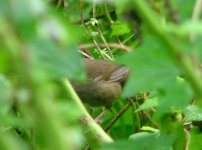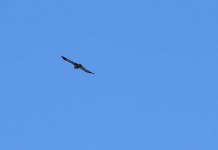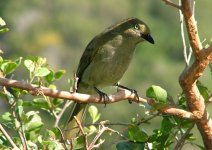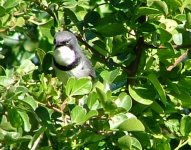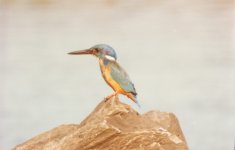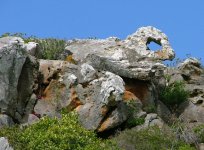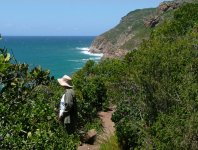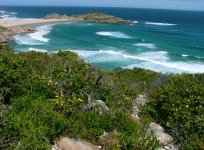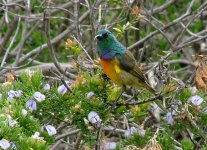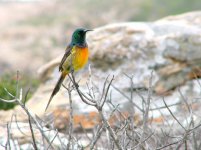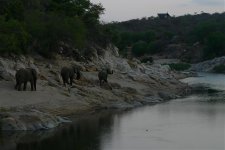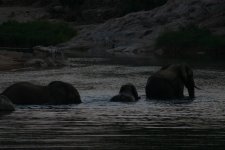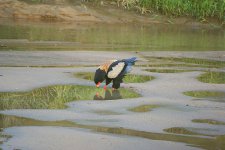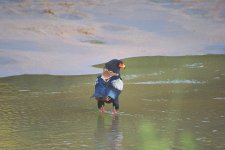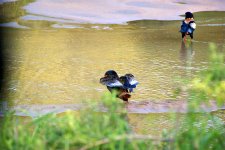Dave Kennedy
Well-known member
Garden Route Birding 3
2. River Gorge Trails
As before……
Note: Birds in heavy type were seen on this trip – others mentioned have been seen on previous visits.
BRUSH UP YOUR BIRD CALLS! They will really help you in forested areas.
Brown-hooded Kingfisher Trail
An easy ±4 km walk through a pretty gorge carved out by the Duiwe Rivier, this trail is one-way only, i.e. you have to return the same way. The trail begins at a tight bend in the road, just as it crosses a drift in the Duiwe Rivier. The Duiwe, more of a trickling stream than a river, tinkles along the floor of its gorge through densely vegetated slopes full of birds. Knowledge of bird calls will be of great assistance here – the call is often your only signpost to the bird’s whereabouts. I have found this little trail to be particularly good for Knysna Turacos, which glide on crimson wings from one side of the gorge to the other. Listen for the tiny scufflings and muted contact calls of the Terrrestrial Bulbuls as they forage among the leaf litter, and the bright cheerful “Willie!” of the Sombre Greenbul. I have seen Yellow-throated Woodland Warbler here, and achieved my first-ever sighting of a Knysna Warbler in the thick undergrowth. Just for a laugh I have attached a photograph of that bird, in that very thicket on the Brown-hooded Kingfisher Trail, just so you can see what you are up against. Their song is a dead giveaway – “chip, chip, chip, chip-chip-chip, chip-chip-chip-chip-CHRRRRRRRRRRR!! A series of slowly-accelerating “chips” culminate in a surprisingly loud machine-gun-like rattle. But beware – even when singing right next to you in the thickets he can be next to invisible.
Pairs of White-necked Ravens patrol the gorge, and the calls of Cape Robin, Black-headed Oriole, and Southern Boubou can be heard on every side. Note also that on the road at the start of the trail, flowers in hedges and along the stream may attract a variety of sunbirds.
Click on the link below to find the start of the Brown-hooded Kingfisher Trail (circled).
NOTE: When your map has finished loading, click on the little arrow half-way up the left-hand margin to open it up.
http://www.multimap.com/s/wUdzBTu8
Half-collared Kingfisher Trail
On the way to the start of this trail we came across an unexpected African Harrier Hawk (you can the see the white stripe across its tail in the photograph, honest) which was harassing a tree-top colony of Grey Herons before flying off across the reedbeds.
This trail begins at the combined road/rail bridge over the Touw River. Again a one-way trail, the distance there and back is around 7km, but there is no necessity to walk all the way to the end if you do not wish to. There are river-side picnic spots along this trail, so if you want to take sandwiches or a flask of coffee, you are welcome. Note that while the trail is not hard, there is a tricky spot near the start which means climbing and descending some fairly steep steps.
The habitat is similar to, but more forested than, the Brown-hooded Kingfisher Trail, and the Touw is a genuine river, very different from the small stream of the Duiwe Rivier. You can, should you so wish, canoe up the river instead, which can be a fine way of seeing the birds. Reed Cormorants and Little Grebes patrol the river, and we had fine views of Malachite and the eponymous Half-collared Kingfishers. Somewhat to my surprise, I managed by whistling to call up a Black-headed Oriole which had been calling some distance away.
While we were there the local bird folk and Wilderness National Park were running a 5-day birding programme in the area, and we met several of the participants on the trail. And I’ll let you into a secret. That very morning the early risers had spotted a juvenile African Finfoot in the Touw River. I learnt subsequently that finfoot are fairly regularly seen in the Kaaiman’s River, just on the George side of Wilderness. It seems likely therefore, that finfoot could be found in any of the rivers tumbling down from the Outeniqua Mountains towards the sea.
A pair of Fish Eagles, madly in love, spent the afternoon soaring, calling and canoodling from the heights above the gorge. A Knysna Warbler, calling obligingly near the little pont used to cross the river, remained stubbornly invisible to a succession of desperate birders trying to spot him. Knysna Turacos glided across the narrow gorge, crashing alarmingly into the trees above our heads. Tiny Dusky Flycatchers, and even smaller Cape White-eyes, foraged in the gloom of the forest, while noisy Bar-throated Apalis called loudly from tangled clumps of undergrowth. Somewhere hidden in the trees a woodpecker hammered on a hollow stump.Yellow-green striped Forest Canaries uttered tiny contact squeaks from bracken thickets. For a while we sat on the river bank watching a Half-collared Kingfisher commuting up and down the river, on each return flight bearing a tiny fish in its beak. It no doubt had a nest upstream from where we were sitting. Note that the photo of the Half-collared Kingfisher was taken at anothe time and at Swartvlei Lake....this one on the Touw River wouldn't sit still for a single second.
Permits should be sought for those trails from the National Parks Office in the Ebb & Flow campsite, close to the start of the Half-collared Kingfisher Trail.
Click on the link to find a map in which the circle indicates the start of the Half-collared Kingfisher Trail and the Ebb & Flow offices.
http://www.multimap.com/s/vXc68VkA
Best wishes,
Dave Kennedy
2. River Gorge Trails
As before……
Note: Birds in heavy type were seen on this trip – others mentioned have been seen on previous visits.
BRUSH UP YOUR BIRD CALLS! They will really help you in forested areas.
Brown-hooded Kingfisher Trail
An easy ±4 km walk through a pretty gorge carved out by the Duiwe Rivier, this trail is one-way only, i.e. you have to return the same way. The trail begins at a tight bend in the road, just as it crosses a drift in the Duiwe Rivier. The Duiwe, more of a trickling stream than a river, tinkles along the floor of its gorge through densely vegetated slopes full of birds. Knowledge of bird calls will be of great assistance here – the call is often your only signpost to the bird’s whereabouts. I have found this little trail to be particularly good for Knysna Turacos, which glide on crimson wings from one side of the gorge to the other. Listen for the tiny scufflings and muted contact calls of the Terrrestrial Bulbuls as they forage among the leaf litter, and the bright cheerful “Willie!” of the Sombre Greenbul. I have seen Yellow-throated Woodland Warbler here, and achieved my first-ever sighting of a Knysna Warbler in the thick undergrowth. Just for a laugh I have attached a photograph of that bird, in that very thicket on the Brown-hooded Kingfisher Trail, just so you can see what you are up against. Their song is a dead giveaway – “chip, chip, chip, chip-chip-chip, chip-chip-chip-chip-CHRRRRRRRRRRR!! A series of slowly-accelerating “chips” culminate in a surprisingly loud machine-gun-like rattle. But beware – even when singing right next to you in the thickets he can be next to invisible.
Pairs of White-necked Ravens patrol the gorge, and the calls of Cape Robin, Black-headed Oriole, and Southern Boubou can be heard on every side. Note also that on the road at the start of the trail, flowers in hedges and along the stream may attract a variety of sunbirds.
Click on the link below to find the start of the Brown-hooded Kingfisher Trail (circled).
NOTE: When your map has finished loading, click on the little arrow half-way up the left-hand margin to open it up.
http://www.multimap.com/s/wUdzBTu8
Half-collared Kingfisher Trail
On the way to the start of this trail we came across an unexpected African Harrier Hawk (you can the see the white stripe across its tail in the photograph, honest) which was harassing a tree-top colony of Grey Herons before flying off across the reedbeds.
This trail begins at the combined road/rail bridge over the Touw River. Again a one-way trail, the distance there and back is around 7km, but there is no necessity to walk all the way to the end if you do not wish to. There are river-side picnic spots along this trail, so if you want to take sandwiches or a flask of coffee, you are welcome. Note that while the trail is not hard, there is a tricky spot near the start which means climbing and descending some fairly steep steps.
The habitat is similar to, but more forested than, the Brown-hooded Kingfisher Trail, and the Touw is a genuine river, very different from the small stream of the Duiwe Rivier. You can, should you so wish, canoe up the river instead, which can be a fine way of seeing the birds. Reed Cormorants and Little Grebes patrol the river, and we had fine views of Malachite and the eponymous Half-collared Kingfishers. Somewhat to my surprise, I managed by whistling to call up a Black-headed Oriole which had been calling some distance away.
While we were there the local bird folk and Wilderness National Park were running a 5-day birding programme in the area, and we met several of the participants on the trail. And I’ll let you into a secret. That very morning the early risers had spotted a juvenile African Finfoot in the Touw River. I learnt subsequently that finfoot are fairly regularly seen in the Kaaiman’s River, just on the George side of Wilderness. It seems likely therefore, that finfoot could be found in any of the rivers tumbling down from the Outeniqua Mountains towards the sea.
A pair of Fish Eagles, madly in love, spent the afternoon soaring, calling and canoodling from the heights above the gorge. A Knysna Warbler, calling obligingly near the little pont used to cross the river, remained stubbornly invisible to a succession of desperate birders trying to spot him. Knysna Turacos glided across the narrow gorge, crashing alarmingly into the trees above our heads. Tiny Dusky Flycatchers, and even smaller Cape White-eyes, foraged in the gloom of the forest, while noisy Bar-throated Apalis called loudly from tangled clumps of undergrowth. Somewhere hidden in the trees a woodpecker hammered on a hollow stump.Yellow-green striped Forest Canaries uttered tiny contact squeaks from bracken thickets. For a while we sat on the river bank watching a Half-collared Kingfisher commuting up and down the river, on each return flight bearing a tiny fish in its beak. It no doubt had a nest upstream from where we were sitting. Note that the photo of the Half-collared Kingfisher was taken at anothe time and at Swartvlei Lake....this one on the Touw River wouldn't sit still for a single second.
Permits should be sought for those trails from the National Parks Office in the Ebb & Flow campsite, close to the start of the Half-collared Kingfisher Trail.
Click on the link to find a map in which the circle indicates the start of the Half-collared Kingfisher Trail and the Ebb & Flow offices.
http://www.multimap.com/s/vXc68VkA
Best wishes,
Dave Kennedy
Attachments
Last edited:




